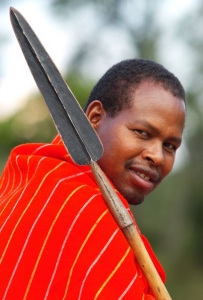Big Cat Diaries: the original wildlife “Soap Opera”.
Big Cat Diary, also known as Big Cat Week and Big Cat Live, was a long-running nature documentary series on BBC television which follows the lives of African big cats in Kenya’s Masai Mara. The series can be viewed on Animal Planet in the US.

Filming was timed to coincide with the arrival of the annual wildebeest migration in the Mara, which is when the most predators gather to take advantage of abundant prey.
Each series has followed the daily lives of a pride of Lions, a family of Cheetahs and a family of Leopards. The long running presenters ; Simon King and Jonathan Scott, gave the Cats’ names and developed personalities for particular cats to draw the audience into a relationship with them. This created empathy for the characters and led to the series being called “the original wildlife soap opera”.
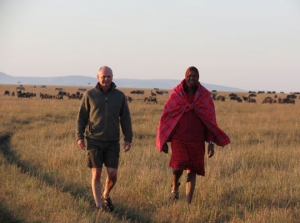
Simon King & Jackson Looseyia
Originally intended to be a one-off series, Big Cat Diary proved so popular that a further eight series have been broadcast to date, plus occasional specials. Recent series have drawn audiences of over 7 million viewers to BBC One, and spawned a number of other programmes using the same ‘Wildlife Diary’ format, including Elephant Diaries, Chimp Week , Big Bear Week and Orangutan Diary . For the first few series, the episodes were broadcast weekly, but since 2004, they have been shown on consecutive nights over the course of a single week. The 2004, 2005 and 2006 series were called Big Cat Week. Since 2005, the Big Cat Diary website has carried additional video footage from the field and in 2006, a spin-off series called Big Cat Uncut was broadcast on BBC Three immediately after the BBC One episodes.
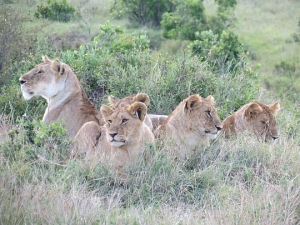
On 5 October 2008, the series returned to British television screens as Big Cat Live, the BBC Natural History Unit’s most ambitious live international broadcast. This is when local Maasai guide Jackson Looseyia joined regular presenters Simon King and Jonathan Scott for two weeks of nightly live programmes on BBC One.
Big Cat Legacies
- The Marsh Pride – Lions of Musiari Marsh
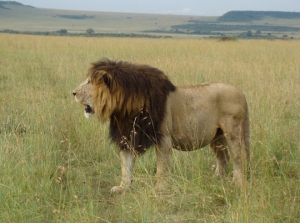
Notch 2010
They have been one of the most successful groups to be filmed for the entire big cat series. The longest-standing member of the pride to be featured on the show was Notch (some of you may know him as Khali ) who was thought to be about eight years old when Big Cat Diary started in 1996. The surviving cubs of the 1998 buffalo attack were the oldest lionesses in the pride: White-Eye and the Blonde Sisters, Bibi and Lispy. There are also the “Three Graces”, Joy, Charm and Beauty, three young females who had broken away from the main pride and formed a satellite group. The Three Graces are the daughters of Notch and were born in 2005. The pride has had a succession of male leaders who were filmed during the series, Scar and Scruffy (1998-2000), Simba and Blondie (2000-2004), Notch and Light Male (2004-2007), Clawed and Romeo (2007-2011). The current leaders of the pride are four males known as the “Four Musketeers” named Scarface, Sikio, Morani, and Hunter. Notch was last seen in 2010, when he was still holding rank in the pride and supporting a huge dark mane.
In 2003 Bibi was kicked out of the pride and was featured on the first series of Big Cat Week as she struggled to raise her two cubs without the support of the pride, though she was later accepted back into the main Marsh Pride.
- Cheetah Mothers of the savannah
In 2005’s Big Cat Week, Jonathan Scott (while following the story of Honey and Toto) introduced viewers to Duma and her mother Sita (some of you may know her as Shakira). In Big Cat Diary: Family Histories, Duma and Toto’s Story, Scott told the story of Duma in more detail, revealing the moment she left her mother to become independent.
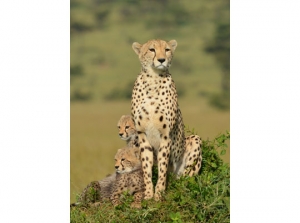
In Big Cat Live in 2008, Scott again followed the story of Sita, when she had 5 cubs of nearly 2 months old. They faced a terrible encounter with the some of the Marsh lions and two cubs died. So far, the three remaining cubs, all female, have survived. The cubs have been called Moja, Mbili and Tatu, meaning “one”, “two” and “three” in Swahili.
- Legendary Leopards of Leopard Gorge and the Talek River
Big Cat Diary only followed one leopard family through each generation. This family started with Half-Tail, a 9 years old female in 1996, one of the most famous big cats who appeared on the show for quite a few years. She was named Half-Tail after a clash with baboons or lions in which she lost half her tail when she was about 6 years old. She is the only leopard in the show who was not shown killing any large prey. Half-Tail only ever managed to raise three cubs. She was killed when she attacked Masai livestock. As her cubs were too young to feed themselves they died shortly afterwards. Shadow was to be the next leopard they followed and she went on to have a cub herself called Safi in 2000, who was rather shy of the cameras. When the show returned in 2002, Shadow had a new litter of cubs. This was her 4th litter but, sadly, all of them died. Shadow was still being seen in 2005 and she was filmed briefly in a special documentary called Big Cat Uncut.
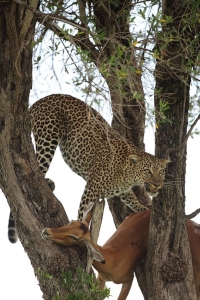
Simon King
Bella and her two cubs of 3 months old were found by presenter Saba Douglas-Hamilton in the 1st series of Big Cat Week in September,2003. Tiny Chui and his sister really provided a promising series. A few months after filming Chui’s sister vanished, presumed dead. In 2005, Chui left his mother, Bella and went his own way. In 2006 he was kicked out by the resident male and Bella was mating again. Chui has now been reported to have moved to an adjacent territory downriver, where he was seen mating with a new female. Viewers were then introduced to Olive – Bella’s daughter from 2000 (before Chui was born). Olive has three cubs, one male, eight-month-old Kali, and two females, Ayah and Binti. Their territory was along the Talek River and Bella, Olive, Ayah, Binti and Kali became known as the “Jackson Five” after new presenter Jackson Looseyia, who was following their progress. The “Jackson Five” is intriguing because three generations of these normally solitary cats are living together.
On 2nd September 2009, Looseyia saw Olive carrying a new cub in her mouth. He belives she had two cubs. Kali had moved on and Bella has since died. Tragically Olive was killed by lions in September 2013. Chui is still alive and has been spotted in the Mara Triangle.
Jackson lives in The Mara and still follows his beloved leopards and other big cats. He regularly posts his sightings on his blog of Jackson Looseyia,
Jackson Looseyia is a Maasai. He has lived all his life in the Masai Mara and everyday he is out on the plains living side by side with the big cats and other wildlife that complete the web of life here. He lives the daily rhythms of the bush and knows where the big cats are hanging out. . He is an eloquent communicator with a twinkle in his eye and a great sense of humour. No wonder the BBC hand-picked him to co-present the ‘Big Cat Diary’ series with Simon King and Jonathan Scott.
Join Jackson in October 2015, when he will be your guide and host on the Big Cat Safari.This safari is based at Rekero Camp on the banks of the Talek River – prime leopard country.


